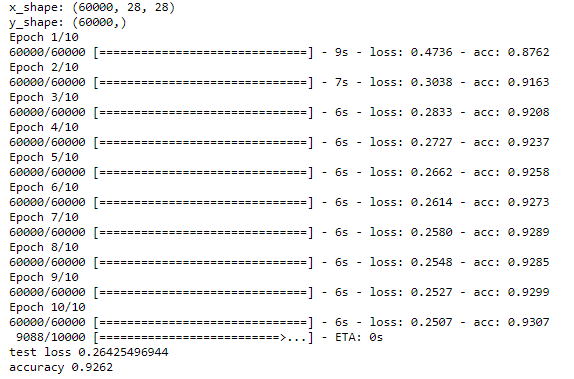1 import numpy as np 2 from keras.datasets import mnist 3 from keras.utils import np_utils 4 from keras.models import Sequential 5 from keras.layers import Dense 6 from keras.optimizers import SGD,Adam
1 # 载入数据 2 (x_train,y_train),(x_test,y_test) = mnist.load_data() 3 # (60000,28,28) 4 print('x_shape:',x_train.shape) 5 # (60000) 6 print('y_shape:',y_train.shape) 7 # (60000,28,28)->(60000,784) 8 x_train = x_train.reshape(x_train.shape[0],-1)/255.0 9 x_test = x_test.reshape(x_test.shape[0],-1)/255.0 10 # 换one hot格式 11 y_train = np_utils.to_categorical(y_train,num_classes=10) 12 y_test = np_utils.to_categorical(y_test,num_classes=10) 13 14 # 创建模型,输入784个神经元,输出10个神经元 15 model = Sequential([ 16 Dense(units=10,input_dim=784,bias_initializer='one',activation='softmax') 17 ]) 18 19 # 定义优化器 20 sgd = SGD(lr=0.2) 21 adam = Adam(lr=0.001) 22 23 # 定义优化器,loss function,训练过程中计算准确率 24 model.compile( 25 optimizer = adam, 26 loss = 'categorical_crossentropy', 27 metrics=['accuracy'], 28 ) 29 30 # 训练模型 31 model.fit(x_train,y_train,batch_size=32,epochs=10) 32 33 # 评估模型 34 loss,accuracy = model.evaluate(x_test,y_test) 35 36 print(' test loss',loss) 37 print('accuracy',accuracy)
